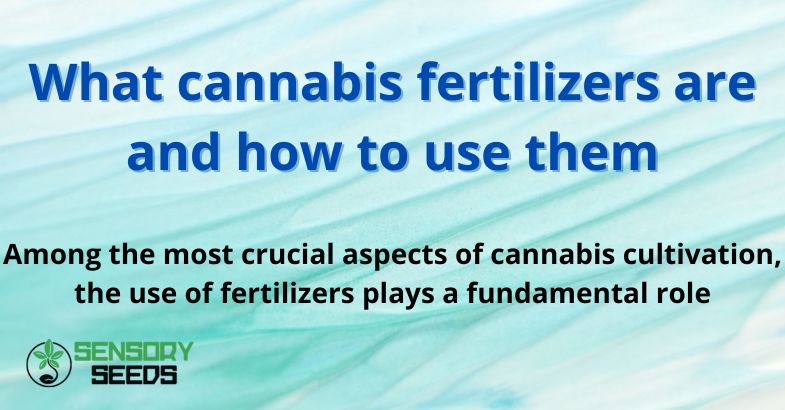Published on: 10/01/2025
Among the most crucial aspects of cannabis cultivation, the use of fertilizers plays a fundamental role
In this article, we will explore what cannabis fertilizers are, how to choose the right ones, and how to best use them to obtain a healthy, productive, high-quality plant.
What is a fertilizer?
A fertilizer is a substance applied to the soil or plants to provide the necessary nutrients for growth. These nutrients, which include macronutrients such as nitrogen (N), phosphorus (P), and potassium (K), as well as micronutrients like iron, manganese, and zinc, are essential for photosynthesis and the metabolic processes that allow the plant to grow and develop. Without an adequate supply of these nutrients, cannabis plants can suffer from deficiencies that compromise their health and productivity.
There are two main types of fertilizers: organic and synthetic. Organic fertilizers come from natural sources such as manure, compost, seaweed, and guano, while synthetic fertilizers are produced in laboratories and contain concentrated chemical nutrients. Both types have advantages and disadvantages, and the choice depends on the grower’s personal preferences, cultivation style, and the specific needs of the plants.
Why are fertilizers important for cannabis?
Cannabis, like all plants, requires a range of nutrients to grow healthily and productively. These nutrients can be naturally provided through the soil or through the use of fertilizers. Fertilizers are particularly useful in cultivations where the soil may not be rich enough in nutrients to support optimal growth.
Using fertilizers helps correct nutrient deficiencies in the soil, promoting vigorous growth, abundant flowering, and overall higher quality harvests. Additionally, fertilizers help improve the plant’s resistance to diseases and environmental stress, making the plants stronger and more capable of handling the challenges of the growth cycle.
Read also : When to harvest marijuana? Here’s how to know when the time is right


Macronutrients and their role
Macronutrients are the primary elements that cannabis plants need to grow. These nutrients are required in relatively high amounts compared to micronutrients, and each plays a specific role in the plant’s life cycle.
- Nitrogen (N)Nitrogen is one of the most important nutrients for vegetative growth. It is essential for chlorophyll production, which is necessary for photosynthesis, and for the growth of leaves and shoots. Adequate nitrogen intake promotes healthy and rapid growth during the early stages of cultivation.
- Phosphorus (P)Phosphorus is crucial for root development and flowering. It helps plants develop a strong root system and bloom abundantly. During the flowering phases of cannabis, providing phosphorus is particularly important to ensure optimal bud and flower production.
- Potassium (K)Potassium supports the overall health of the plant by contributing to disease resistance, the transport of water and nutrients, and the synthesis of proteins and sugars. Potassium is important during all stages of growth but is especially crucial for flowering and the maturation of flowers.
Each of these macronutrients plays a vital role in ensuring the healthy and productive growth of cannabis plants, supporting them through their various stages of development.
Micronutrients and their role
Although cannabis plants require macronutrients in larger quantities, micronutrients are equally important for ensuring healthy growth. These nutrients are needed in smaller amounts, but they are still essential for the plant’s biological processes.
Iron, manganese, and zinc are just a few of the micronutrients cannabis needs. These nutrients are involved in various processes, such as enzyme synthesis and protection against oxidative stress. Deficiencies in micronutrients can lead to metabolic dysfunctions in the plant and reduce the overall quality of the harvest.
Micronutrients play key roles in maintaining the plant’s health, ensuring proper enzymatic functions, and enhancing its ability to deal with environmental stress, ultimately improving both growth and the quality of the final product.
Types of cannabis fertilizers
There are several types of fertilizers available on the market, and the choice depends on the specific needs of the plants, soil conditions, and the grower’s preferences. Here’s an overview of the main types of fertilizers for cannabis.
Organic fertilizers
These fertilizers come from natural sources such as manure, compost, seaweed, and guano. They are ideal for growers who prefer a more natural approach to cultivation and want to avoid the use of chemicals. Organic fertilizers release nutrients slowly into the soil, meaning the risk of overdosing is reduced. However, they may take longer to provide the necessary nutrients and might not be as effective in nutrient-poor soils.
Synthetic fertilizers
These fertilizers are chemically produced and contain nutrients in highly concentrated and soluble forms. They are ideal for growers who want precise control over nutrient levels and faster absorption by the plants. However, excessive use of synthetic fertilizers can lead to salt buildup in the soil, which can damage the roots and compromise the quality of the plants.
Slow-release fertilizers
These fertilizers are designed to release nutrients gradually over time. They are particularly useful for growers who want a consistent feeding schedule for their plants without the need for frequent fertilization. Slow-release fertilizers are often made from organic ingredients and can be applied at the beginning of the growth cycle.
Liquid fertilizers
Liquid fertilizers are easy to apply and are quickly absorbed by the plant’s roots. They are particularly useful in hydroponic cultivation, where precise nutrient control is essential. Liquid fertilizers are also suitable for foliar application, allowing plants to absorb nutrients directly through their leaves.
Read also : How to identify and solve nutritional problems in cannabis plants


How to use fertilizers for cannabis
Correct use of fertilizers is crucial to avoid damage to the plants and maximize the quality of the harvest. Here are some tips on how to use fertilizers for cannabis.
1. Understanding the needs of the plant
Each stage of cannabis growth has different nutritional requirements. During the vegetative phase, the plant needs a fertilizer rich in nitrogen to promote the growth of leaves and shoots. During flowering, however, the plant requires more phosphorus and potassium to support flower development. It is important to choose a fertilizer that is suitable for the specific growth stage the plant is in.
2. Dosing fertilizers correctly
Overdosing on fertilizers can damage the roots and lead to a “burning syndrome” in the leaves, which manifests as brown spots and curled edges. To avoid this issue, it is essential to follow the dosage instructions provided on the fertilizer packaging. If using a liquid fertilizer, it is advisable to dilute it properly to prevent excessively high concentrations.
3. Applying fertilizers at the right time
Timing is another crucial factor when using fertilizers. During the vegetative stage, fertilizers should be applied every 1-2 weeks to support healthy growth. During the flowering stage, the frequency can be reduced, as the plant’s nutrient needs change. It is important to avoid fertilizing during the drying phase, as the plant is not able to absorb nutrients at that time.
4. Monitoring soil and plant health
A good cannabis grower is always alert to the signals that the plants send. Yellowing leaves, slowed growth, or flowers not developing properly can be indicators of nutritional deficiencies. Regularly monitoring the health of the plant allows for timely adjustments in fertilizer management to ensure optimal growth.
Conclusion
The use of fertilizers is essential for growing high-quality cannabis, but it requires a deep understanding of the plants’ nutritional needs. Choosing the right type of fertilizer, applying it correctly, and constantly monitoring the health of the plants are crucial steps to achieve an abundant and healthy harvest. Whether using organic or synthetic fertilizers, each grower must experiment to find the best solution for their plants, always taking into account the specific soil conditions and cultivation type.









